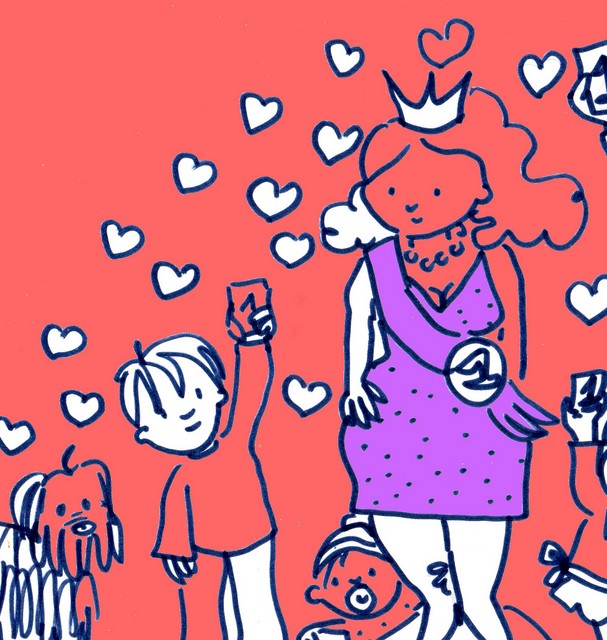Making Peace With Our Bodies
 How parental example setting is crucial for children’s attitudes towards healthy and sustainable food choices.
How parental example setting is crucial for children’s attitudes towards healthy and sustainable food choices.
Today’s society places a lot of emphasis on appearance. Women, and to a lesser extent men, are being impacted, and there has also been a growing trend of increased pressure for young girls and boys.
The television, Internet and magazines are awash with (usually photoshopped) images of weight-loss, diets, make-up, makeovers, plastic surgery, quick fixes, anti-ageing lotions and potions. Even some children’s toys can give the wrong message – consider Barbie’s proportions, or the shrinking waistlines of Disney Princesses. As parents, we need to consider that inner beauty is not appropriately valued in the media; that the message portrayed to our youth is that being you is not considered good enough, and that size and beauty equate to success and happiness.
Excessive focus on body shape and weight can influence the food choices that both we ourselves and our children make; extreme dieting may result in a yo-yo effect and cause nutritional imbalances with potentially damaging consequences. Conforming to a specific body size is unrealistic; we all come in various shapes and sizes and have different genes and metabolisms – that’s what makes us individuals. The devastating outcome has been an increase in eating disorders, which is characterised as having an abnormal attitude towards food that can alter an individual’s eating habits and behaviour. The two most common eating disorders that tend to start in the teenage years are:
- Anorexia nervosa: The fear of gaining weight is obsessively controlled by food restriction, often in conjunction with exercising excessively.
- Bulimia nervosa: Binge eating is followed by self-induced vomiting and/or the use of laxatives.
Although media and social pressure play a major role, there are often additional, more complex factors that may trigger an eating disorder, including:
- Family history of eating disorders, depression or substance misuse
- Bullying or criticism of eating habits, body shape, looks or weight
- Characteristics such as an obsessive personality, an anxiety disorder, low self-esteem or being a perfectionist
- An experience such as sexual or emotional abuse, or the death of someone close
- Major disruption to daily life, such as parents separating, changing schools or moving to a different country
- Difficult relationships with family or friends
- Stress
As a parent or carer, it is important to set a good example for our children: if you are constantly talking about your weight and dieting, or using food to cope with your emotions, it would be unfair to expect your child to behave differently. Children are impressionable, and they observe behaviours that one may think go unnoticed; taking pride in your body and making conscious food choices demonstrates a positive approach. Consider what you are reading and watching, as well as the products that you purchase, and translate this into the message that you are conveying to your children.
Setting a Good Example: 8 Tips
- Eat together as a family, and openly discuss how food choices can affect health, appearance and energy levels.
- Encourage a healthy body image; ban hurtful nicknames or jokes based on a person’s physical characteristics, and lead by example: avoid making comments about another person based on weight or body shape.
- Use food for nourishment and never as a bribe or punishment.
- Establish healthy eating habits. Offer healthy meals and snacks and involve your children in the grocery shopping and cooking.
- Explain the dangers of dieting, and that food should not be used as a coping mechanism for emotions. Rather, we should confide our worries to loved ones, trusted friends or a therapist.
- Explain the effects of puberty and genetics. Make sure weight gain is understood to be a normal part of development, especially during puberty.
- Monitor what your children are reading or watching, and encourage them to discuss and question what they have seen or heard.
- Promote physical activity that does not emphasise a particular weight or body shape.
Should you suspect that your child has an eating disorder, with signs such as wearing baggy clothes to hide weight loss, exercising excessively or reluctance to eat meals with the family, encourage her or him to open up about problems or concerns. If you or your child is struggling with negative body image, consider professional counselling.
The Zinc Link
Since the 1980’s, various studies confirm favourable results by supplementing zinc in patients suffering with anorexia nervosa and bulimia nervosa on the back of a discovery made by Rita Bakan. She noticed the symptom overlap of anorexia and zinc deficiency, namely: weight loss, loss of appetite, absence of menstrual period, impotence in males, nausea, skin lesions, malabsorption, disordered thoughts, depression and anxiety. The risk factors also overlapped: puberty, stress, and females under 25.
Zinc is necessary for our sense of taste, and therefore may support appetite; additionally, it plays an important role in the growth and development of teenagers.
Foods rich in zinc include: shellfish (mussels, crab, lobster, prawns, crayfish), sardines, chicken, turkey, lamb, cashews, pumpkin seeds, oats, brown rice, chickpeas, quinoa and buckwheat.
By Claudette Lucien
Claudette is a nutritional therapist, metabolic balance® coach and GAPS™ practitioner with her own practice, Your Nutrition Balance. She is South African and has lived in Zurich since 2008, having previously worked and studied in London for 11 years. To find out more about her work, visit her website: www.yournutritionbalance.com.
Illustration by Albina Nogueira
Albina Nogueira has been a primary school teacher since 1992, and a writer and illustrator since 2006. She currently lives in Switzerland, but her homeland is Portugal. She is also the author of Letters to Grandparents and Hairdresser. To find out more, like her on Facebook or see her books in Amazon.



